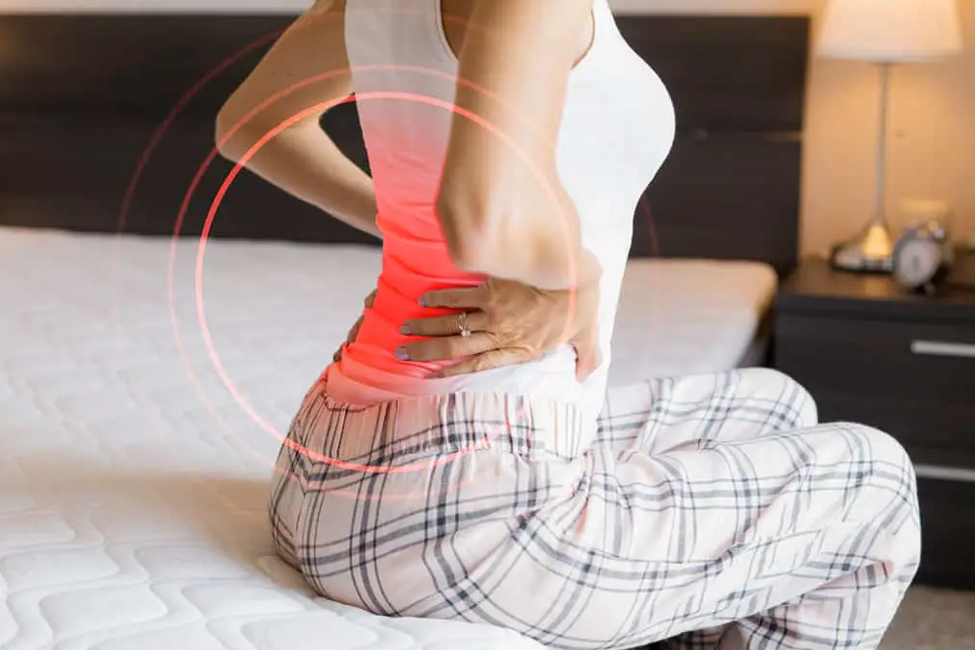Spondylolisthesis: Causes, Symptoms, Treatment, and Prevention
What is Spondylolisthesis?
Spondylolisthesis is like a puzzle piece in your spine moving out of place. Your spine comprises many small bones called vertebrae; sometimes, one can slip forward over the one below it. This can happen because of age, injury, or other reasons. When it does, it can pressure your nerves and cause pain.
Type of Spondylolisthesis
There are different types of spondylolisthesis, but we’ll talk about the two most common ones:
Isthmic Spondylolisthesis: This is like a crack in the puzzle piece. It usually happens in childhood or adolescence, making the vertebra slip forward.
Degenerative Spondylolisthesis: This is more like wear and tear over time. As you get older, the parts of your spine can change, and one vertebra might slip forward.
How Common is Spondylolisthesis?
Spondylolisthesis isn’t super common, but it’s not super rare either. Some might not even know they have it because it doesn’t always cause symptoms. It’s more common in older adults and athletes, especially those who do a lot of bending and twisting, like gymnasts or football players. But remember, it can happen to anyone at any age.
Causes of Spondylolisthesis
Spondylolisthesis happens when a puzzle piece in your spine, called a vertebra, slips out of place. There are a few different reasons why this can occur:
- Isthmic Spondylolisthesis: This type is often caused by a tiny crack in the puzzle piece, usually from childhood or adolescence. It’s like having a weak spot in the vertebra that allows it to slip forward.
- Degenerative Spondylolisthesis: This is more about wear and tear as you get older. Over time, the parts of your spine change, and one vertebra might slip forward, similar to how a car tire can wear out over the years.
- Traumatic Spondylolisthesis: A sudden injury or accident can sometimes force a vertebra to move out of place. It’s like the puzzle piece getting knocked out of position.
- Pathological Spondylolisthesis: This happens when a disease, like an infection or tumour, weakens the vertebra and makes it slip. It’s like the puzzle piece becoming fragile and shifting.
- Dysplastic Spondylolisthesis: In this case, you’re born with a vertebra that’s not shaped quite right. This abnormal shape can make it easier for the vertebra to slip forward, almost like having a puzzle piece that doesn’t fit perfectly.
Symptoms of Spondylolisthesis
Spondylolisthesis can cause various symptoms, but not everyone with this condition experiences the same problems. Here are some common symptoms simplified:
- Back Pain: The most common symptom is back pain. It’s like a constant ache in your lower back, similar to when your back is tired after a long day.
- Leg Pain: Some people also feel pain that goes down one or both legs. It’s like a shooting or burning sensation, and it happens because the slipped vertebra can put pressure on the nerves in your spine.
- Stiffness: You might feel like your lower back is stiff and less flexible than usual. It’s like your back wants to move slowly.
- Numbness or Weakness: In some cases, you might notice numbness or weakness in your legs. It’s like when your foot falls asleep and is harder to move.
- Difficulty Walking: If the nerves in your spine are affected, it can make walking harder or even cause a limp. It’s like feeling unsteady on your feet.
- Tingling Sensation: You may experience a tingling sensation in your legs or buttocks. It’s similar to when your hand or foot “falls asleep.”
- Bowel or Bladder Changes: In rare and severe cases, spondylolisthesis can pressure the nerves controlling your bowel or bladder, leading to issues like incontinence.
Diagnosis of Spondylolisthesis
When doctors suspect spondylolisthesis, they use a few steps to figure it out:
Medical History
Your doctor will talk to you about your symptoms and medical history. They’ll ask about any injuries or conditions you’ve had that might be related.
Physical Examination
The doctor will check your posture, spine flexibility, and any signs of pain, weakness, or numbness in your legs.
Imaging Tests
To get a clear picture of your spine, your doctor might use these tests:
- X-rays: Like taking a picture of your spine, X-rays can show if a vertebra is out of place.
- CT Scan (Computed Tomography): This more detailed scan provides a 3D view of your spine.
- MRI (Magnetic Resonance Imaging): An MRI gives a clear look at the soft tissues in your spine, like nerves and discs, which helps identify if they’re affected.
- Grade Measurement: Doctors use a grading system to determine the severity of spondylolisthesis, ranging from grade 1 (mild) to grade 5 (severe). This helps guide treatment decisions.
Other Tests
Sometimes, your doctor may order additional tests to check for nerve function or complications like bowel or bladder problems.
Complications of Spondylolisthesis
While spondylolisthesis itself can cause discomfort, it can also lead to some complications, including:
- Nerve Compression: When a vertebra slips out of place, it can pressure the nerves in your spine. This pressure can cause pain, numbness, weakness, or tingling sensations in your legs.
- Spinal Stenosis: Over time, spondylolisthesis can lead to a condition called spinal stenosis, where the spinal canal narrows. This can further squeeze and irritate the nerves, worsening symptoms.
- Reduced Mobility: Spondylolisthesis can make your spine less flexible and affect your ability to bend or twist comfortably. This reduced mobility can impact your daily activities.
- Chronic Pain: The ongoing discomfort and pain associated with spondylolisthesis can affect your quality of life and well-being, potentially leading to chronic pain.
- Difficulty Walking: Severe cases may result in difficulty walking, balance issues, or even a limp due to nerve compression or muscle weakness.
- Bowel or Bladder Dysfunction: In rare instances, spondylolisthesis can put significant pressure on the nerves controlling bowel and bladder function, leading to issues such as incontinence.
Treatment Options for Spondylolisthesis
When dealing with spondylolisthesis, the treatment approach depends on your condition’s severity and symptoms. Here are the main treatment options:
Observation and Lifestyle Modifications
If you have mild spondylolisthesis without significant symptoms, your doctor might recommend lifestyle changes like avoiding activities that worsen the condition, physical therapy, and pain management.
Physical Therapy
Physical therapy can help improve spine strength, flexibility, and posture. Therapists will teach you exercises and techniques to relieve pain and prevent further slippage.
Medications
Pain-relieving medications like over-the-counter pain relievers (e.g., ibuprofen) or prescription drugs may be used to manage discomfort and inflammation.
Bracing
In some cases, a back brace may be recommended to provide support and stability, especially for children and adolescents with spondylolisthesis.
Injections
Epidural steroid injections can reduce inflammation and alleviate pain if you’re experiencing nerve-related symptoms.
Surgery
If conservative treatments don’t work or if your condition is severe, surgery might be necessary. The type of surgery depends on the cause and location of the spondylolisthesis. Common procedures include spinal fusion, laminectomy, and decompression surgery.
Lifestyle Adjustments
Lifestyle modifications can help manage spondylolisthesis. This may involve avoiding activities that worsen your symptoms, maintaining a healthy weight, and practising good posture.
Preventing Spondylolisthesis
While you can’t guarantee prevention, you can take steps to reduce the risk of spondylolisthesis:
- Keep a healthy weight to lessen the strain on your spine.
- Strengthen your core and stay flexible for better spine support.
- Bend your knees when lifting to protect your back.
- Sit and stand with proper posture to reduce spine stress.
- For athletes: use correct techniques and allow time for rest.
- Proper hydration supports your spine’s discs.
- Use ergonomic tools to reduce spine strain at work.
- Visit your doctor for routine checkups and address back pain.
- Smoking can hinder spine healing; consider quitting if you smoke.
Living with Spondylolisthesis
Living with spondylolisthesis means managing your daily life while considering your spine’s health. Here’s how to do it:
- Identify pain triggers and use medication or therapies to ease discomfort.
- Engage in spine-friendly exercises recommended by experts.
- Maintain good posture to reduce strain on your back.
- Follow proper lifting techniques to protect your spine.
- Manage your weight through diet and exercise for spine health.
- Create a comfortable workspace with ergonomic tools.
- Practice stress-relief techniques to minimise emotional strain.
- Keep appointments with your doctor and share concerns promptly.
- Be open to lifestyle adjustments, modifying activities, or using aids as required.
Living with spondylolisthesis requires mindful management, but leading a fulfilling life is possible. Remember to follow the practical tips to support your spine and well-be
Don’t hesitate to take the next step if you’re experiencing persistent discomfort or need expert guidance on spondylolisthesis. We encourage you to request an appointment with The Orthopaedic Practice and Surgery Clinic. Our specialists can provide personalised care and help you navigate your spondylolisthesis journey with confidence. Your spine health matters, and taking action today can significantly impact your tomorrow.












